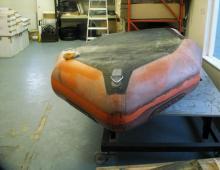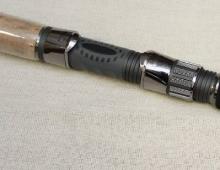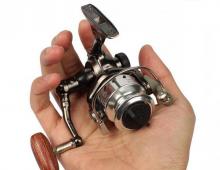How to choose a feeder rod for beginners
Choosing a feeder rod requires certain knowledge. If you are a complete beginner and only comprehend all the intricacies of fishing, then our tips will be very useful for you.
In this article, we focus on the right feeder for a beginner angler. Let's analyze the main criteria for choosing a feeder rod, depending on the conditions of fishing.
What length of feeder rod to choose
The length of the feeder rod can vary from 2.7 to 4.8 meters. For the first feeder rod, it is optimal to choose a rod with a length of 3.3-3.6 m. But, choosing a feeder rod by length, you should focus on the casting distance that you will need. If you are going to fish on a small lake, pond or stream, then you can safely choose a shorter rod - it will be easier for you to control it and the shores abundantly overgrown with vegetation will not become a particular hindrance. If fishing will take place on a large river or reservoir with a width of more than 100-150 meters, then you will need a rod of 3.6 meters or more.
Do not forget also that it is much more pleasant to fish with a shorter and thinner rod. If you plan to catch carp with a maximum weight of up to 0.5 kg, then it will be much more pleasant to play it on a more delicate tackle. In addition, a rough stick, when catching small fish, absorbs much worse, which will lead to frequent gatherings of fish.
If you plan to catch fish over 0.5 kg, and this is usually carp, silver carp and grass carp, then here a rod 3.6 meters long will be the most suitable.
As mentioned above, a rod with a length of about 3.3-3.6 meters is the most versatile. Such a feeder will allow you to comfortably catch both small and large water bodies, it will cope with both large and small fish. Therefore, if you are in doubt when choosing a rod length, feel free to take a feeder 3.6 meters long.
Which feeder test to choose

The rod blank test implies the load for which it is designed, namely what weight the feeder will be used. If you use a feeder lighter than the test indicated on the form of the feeder, then you will significantly lose the sensitivity of the feeder, and if the weight is higher than the upper limit of the test, then you risk breaking the rod.
According to the test, feeder rods are divided into:
• Ultralight (Ultralight) - up to 40 g;
• Light (Light) - up to 80 g;
• Medium (Medium) - 80-100 g;
• Heavy (Heavy) - 100-120 g;
• Superheavy (Extraheavy) - 120 g and more.
The higher the rod test, the heavier the feeder can be used. Accordingly, the further you can throw the bait. Also, when choosing a rod test, one should take into account the reservoir, or rather the strength of the current in it. When fishing in the current, you need to choose a feeder with a weight that will not be carried away by the current, so when choosing a feeder test, be guided by the speed of the current and the casting distance.
It should be borne in mind that with a bad biting it is better to use the feeders as lightly as possible. Often in cold water, when the fish is very cautious, you have to catch on feeders weighing 20-30 grams. And throwing such a feeder with a rod with a test of 60 grams is far from possible. For light feeders, a lighter feeder is also needed.
If you have not yet decided which test to choose a feeder, pay attention to the most versatile option - a middle-class rod with an upper test of up to 90-100 grams. Such a test will be optimal for a beginner angler and is suitable for most fishing conditions. And then, based on your practice, you will be able to understand which test of the next feeder is best for you.
Feeder material - which is better

Their price directly depends on the material of the feeder rod. Here you have to make a choice based on your financial capabilities. Let's take a look at each material and find out their features.
1.Graphite- the most expensive material for the manufacture of the feeder. It has many advantages, the main one is its weight. The feeder made of high-modulus graphite is really very light and it is very comfortable to fish with it. Such rods withstand huge loads when playing fish, but are very sensitive to mechanical damage, such as hitting the sides of the boat, stones and other hard objects. Such rods must be handled very carefully and make sure that there is no sand and small pebbles at the junction of the knees, otherwise the rod will wear out very quickly. For beginners - not the best choice.
2. Composite. Feeder rods made of composite are an order of magnitude cheaper than graphite rods, but already have more weight. They no longer require such a careful attitude and forgive many mistakes in handling. So for a beginner, such a rod is quite suitable, and it will cost less.
3. Fiberglass. The cheapest feeders are made of fiberglass. This is the most durable material of all of the above. But such rods are quite heavy and rigid, which will cause some inconvenience in the process of fishing. For beginners who just want to try feeder fishing, this is what you need.
Feeder rod build

According to the system, feeder rods are divided into:
• fast (fast);
• averages (moderate);
• slow (slow).
For a beginner, a medium-action feeder rod would be the best option, because it has average characteristics and is ideal for an inexperienced feederist. The blank of such a rod bends to the middle, which allows you to soften the jerks of large fish and, at the same time, not experience discomfort when casting.
Which brand of feeder to choose
If your fishing budget is limited - do not rush to spend all your money on a "cool" rod of a famous brand. You can try to find a relatively good Chinese-made feeder and practice on it. Below are the manufacturers you can trust:
• Salmo;
• Shimano;
• Mikado;
• Sabaneev;
• Volzhanka.
Which coil to choose for the feeder
One of the important components of a feeder rod is the reel. The best option would be a spinning reel size 4000 according to Shimano classification (3500 according to Daiwa classification). Choose more traction reels, that is, with a lower gear ratio, because when fishing on a feeder, rather heavy feeders are used. For this type of fishing, it is more convenient to reel with a rear friction clutch without a baitrunner.
The reels described above are perfect for light, medium and heavy rods. That is, they are suitable for all classes of feeder rods, with the exception of the most extreme - Ultra light and Extra Heavy. But for beginners, as a rule, these classes are not interesting.
Conclusion
We dismantled feeder rods according to all characteristics and now we know which one is better to choose. Now you need to collect all the new information and get a concrete example of a feeder, which is perfect for a beginner feederist.
But why only for beginners? This “stick” is also used by many amateurs and professionals who have been engaged in feeder fishing for several years.
So, the ideal first feeder:
• Length 3.6 meters.
• Test - 60-100 grams, ie Heavy class.
• Material - composite (if you need cheaper, you can
fiberglass, but it is heavier).
• Build - average.
• Coil - 4000 Shimano.
Such a feeder will be the ideal solution for you for at least a couple of seasons! Perhaps these are the rods you will use all the time. Good luck with your choice of tackle and - no tail, no scales!



